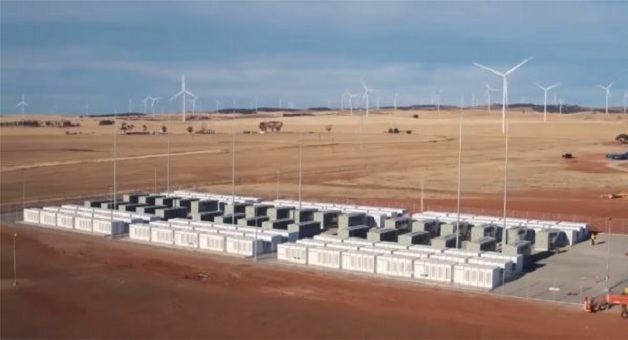Let’s take a look at the newest high-power batteries for electric vehicles (EVs) and grid energy storage applications being produced by Tesla at its Gigafactory in Nevada.
21700 Battery Cell
Tesla is upgrading its battery technology with a 21700 battery cell, which it has been manufacturing since early 2017 at its Gigafactory in Nevada. CEO Elon Musk said that the factory is already producing more batteries than any other factory in the world.
Instead of the smaller 18650 cells used in Model S and Model X, 21700 Li-ion cell is used in the Model three. The 21700 (Figure 1) has a diameter of 21mm and length of 70mm. Tesla calls it their 21-70 battery. The 21-70 cell volume is 24.245mm³ that is 46 percent more than the 18650 cells. They are also about 15 percent more ‘energy efficient,’ says J. B. Straubel, Tesla’s chief technology officer. Energy density is thought to be 877.5Wh/L and cell capacity is 21.275Wh. Energy density is a very fluid specification because the depth of charge and discharge has a big effect on lifetime and, thus, charge controller programming has a big say-so about the trade-off between the two.
21700, 20700, and 18650 size battery cells
Most Li-ion batteries have a maximum charged voltage of 4.20V/cell, and every reduction in peak charge voltage of 0.10V/cell is said to double the cycle life. For example, a lithium-ion cell charged to 4.20V/cell typically delivers 300–500 cycles. If charged to only 4.10V/cell, the life can be prolonged to 600–1,000 cycles; 4.0V/cell should deliver 1,200–2,000 and 3.90V/cell should provide 2,400–4,000 cycles. A lower peak charge voltage reduces the capacity the battery stores. As a guideline, every 70mV reduction in charge voltage lowers the overall capacity by 10%. For absolute best longevity, the optimal charge voltage is 3.92V/cell (this may vary with chemistry). This threshold eliminates all voltage-related stresses; going lower may not gain further benefits, and may induce other symptoms.
The Li-ion 21-70 and the older 18650 cells used in Tesla vehicles have nickel cobalt aluminum (NCA) chemistry. For its stationary energy storage products, like the Powerwall and Powerpack, the company uses nickel manganese cobalt oxide (NMC) cells, which will have a longer cycle life, but less energy density. What, if any, chemistry changes were designed into the new 21700 size cell is a mystery. Tesla hasn’t said, but it’s rumored that it added more silicon to the anode to achieve higher charge density.
Battery makers Sony, Efest, Panasonic, LG, and Samsung all make 21700 Li-ion cells. Efest has a 3700mAh cell with 35A maximum discharge rate. The Samsung INR-21700-48G cell offers 4800mAh and 9.6A maximum discharge rate and Samsung has also introduced new “integrated battery modules” intended for EVs. Detailed information on these products is very hard to find at this point in time.
Although Li-ion batteries are generally referred to by this generic name, there are several different types. They have many similar characteristics, and each has its own – including number of charge cycles, which varies from 1,500 to 5,000+
Li-Ion Battery Chemistries
| Lithium Cobalt | Li-CoO2 | LCO | Cellphones, laptops, and cameras |
| Lithium Manganese Oxide | Li-Mn2O4 | LMO | Power tools, medical, hobbyist |
| Lithium Iron Phosphate | Li-FePO4 | LFP | Power tools, medical, hobbyist |
| Lithium Nickel Manganese Cobalt Oxide | Li-NiMnCoO2 | NMC | Power tools, medical, hobbyist |
| Lithium Nickel Cobalt Aluminum Oxide | Li-NiCoAlO2 | NCA | Electric vehicles and grid storage |
| Lithium Titanate | Li4Ti5O12 | LTO | Electric vehicles and grid storage |
Grid Energy Storage System Batteries
Tesla is heavily invested in energy storage with their consumer Powerwall battery and much larger systems for grid optimization. Recently they unveiled a very large system that uses 21700 size batteries – but not the one you would expect.
Tesla has delivered the world’s largest battery energy storage system (ESS) in South Australia and Adelaide.
The 100 MW/129MWh Hornsdale Power Reserve is part of South Australia’s plan to integrate renewable energy and provide back-up power services for the 309MW Hornsdale wind farm. The ESS was energized for the first time in November, 2017, and reached 31MW in two minutes, according to Audrey Zibelman, the leader of Australia’s energy market operator. In order to meet strict deadlines, Tesla obtained its 21700 size batteries from Samsung for the system, apparently because of heavy commitments for EV production.
The battery energy storage system is the enabling technology for the modern electric grid. These systems improve grid reliability and support the ability of grid operators to manage increasingly variable loads and resources like wind and solar. In addition, microgrid systems using solar and wind generation combined with ESS can provide reliable power in remote areas – a very large market with a potentially extremely large impact on world health and well-being.








